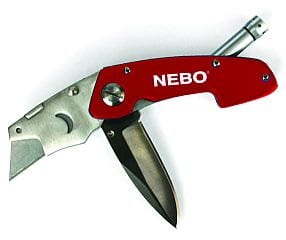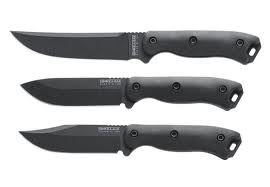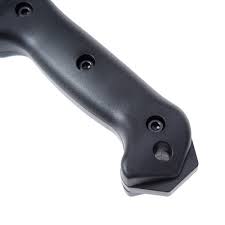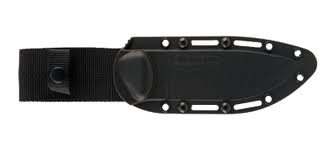General
A Guide to Blade Steel Types
There are a lot of things that go into making a knife, but none make more of a difference to the overall quality of the cutting tool than the actual blade itself. You can have the most ergonomic knife that is both perfectly balanced and looks great, but if the blade steel isn’t up to scratch — it’s just no good. If you’re a prospective knife buyer, then learning all of the various terms and options surrounding knife steel types can be a daunting task. So in this blog, we’ll go over some of these common steel types, as well as what you want in a blade.
Common Blade Steel Types
Steel is a very strong and durable metal. Its uses are as varied as the names we have for its many different grades. Steel itself is a broad term used to describe combinations of different metal alloys. Different amounts of these alloys are used to create the various grades of steel out there. Though there are many sub-types of steel, the three most common forms used in knife making are the ones we’ll discuss below.
Stainless Steel
The first blade steel we’ll cover also happens to be the most widely used. There are a number of reasons for this, such as the fact that stainless steel has a very low requirement for maintenance and has the propensity to bend rather than break when put under more extreme loads. This is because stainless steel is not the hardest of materials, but it is very durable.
So what is it that makes stainless steel actually stainless? Well, to start with, no steel is truly stainless, and it’s worth noting that if left out in the elements for enough time, all metals will show signs of corrosion. But in the case of stainless steel, it’s the inclusion of an alloy known as chromium that gives it the stainless characteristic. In order for the steel to be classified as ‘true stainless’, there needs to be a minimum of 13% chromium content in the knife. Less than that amount and the steel is classified as ‘semi-stainless’.
When most ordinary steel types make contact with oxygen, they have a reaction over time (oxidation) that produces the red oxide we know as rust. But when the steel is manufactured with chromium, that same reaction still occurs, but rather than producing rust, it produces a different oxide which actually coats the steel in a protective layer. This inhibits rust from forming on the knife.
One of the drawbacks of stainless steel is that you need to keep it away from high-temperature situations. This is because heat tends to cause the oxidised chromium layer to break down and reduce the effectiveness of the coating.
Carbon Steel
Next up, we have carbon steel. Carbon steel gets its name due to the process of dissolving up to 2% carbon with heated iron. This is then rapidly cooled, and the carbon becomes trapped inside the iron.
Basically, carbon steel is brilliant at all the things that stainless steel isn’t — and the same is true the other way around. For example, carbon steel is an incredibly hard blade steel. It can withstand higher loads than stainless steel is capable of and is far less susceptible to heat. However, the catch with carbon steel is that when the tolerable load of the blade is exceeded, it’s more likely to break rather than bend. The same is true for the edge of the knife where you’re most likely to see small chips in the blade edge, rather than slight deviations that can be brought back into alignment.
Despite this, carbon steel is used in a huge range of knives, particularly at the premium end of the spectrum. Carbon blades can be sharpened into a supremely sharp edge, and their ability to hold that edge even after extensive use is mostly unmatched by other knife steel types. For this reason, carbon steel is used by many professional chefs and knife enthusiasts. It is suited for owners that are ready and willing to put a bit more effort into giving their knife regular maintenance.
Tool Steel
Tool steel is the third on our list and is probably the least common material of these three when it comes to knife-making anyway. But that doesn’t make it a bad option. Metals can generally only be worked on by other, harder metals. This is where tool steel comes in. Its main goal in production is to be as strong and durable as possible. Tool steel quite often contains both chromium and carbon additives, but not enough of either to be definitively classed as stainless steel or carbon steel.
As a result, tool steel sits as a bit of an all-rounder. It’s quite good in most categories but not a standout in any particular one. A proper no-nonsense blade steel.
What to Look for When Choosing a Blade Steel
Choosing the best blade steel is less about finding the overall best material and more about finding the perfect material for your intended use. Each blade material is going to have certain compromises, and that’s really all part of the game. Here we’ll take a look at the main metrics people use to assess the performance of a knife steel type.
Hardness and Durability
These two go together but they are not the same thing. In the context of knife performance, they can even be opposites. An example of this is when comparing carbon and stainless steel blades. Carbon is harder, no doubt. It takes more to damage it but when it does get damaged the blade could break, which isn’t an especially durable characteristic. Stainless on the other hand is going to start bending much earlier than carbon, but it does bend — not break. A knife can be bent back to shape, we can’t say the same for breakages.
Resistance to Corrosion
This one is pretty simple, some blades will rust easier than others. Just because a knife is susceptible to corrosion does not mean it’s bad, but it’s an important consideration if you’re not going to have the time or ability to maintain it.
Type of Use
This is an important factor. Obviously, this is not a feature of the steel, but it is going to make a difference in which blade steel you should choose. Regular use in salty or acidic environments for example will likely cause early wear to a carbon blade. Use in high-heat situations or on very dense materials will also cause high wear on a stainless steel blade.
Edge Retention
This is a tricky one and it’s largely subjective. The edge retention of a knife can be greatly affected by the way it was sharpened, the technique used to sharpen it, what you use it for, and how often. However, certain blade steels tend to hold an edge better than others. Carbon steel is known for its superior edge retention, and certain tool steels are known for the same. Although they are likely to be less sharp initially.
Our Top 3 Best-Selling Steel Types
These are the blades that get our customers excited. We’ve chosen one from each category discussed and shown their relative pros and cons.
D2 Stainless Steel
Again starting with stainless, D2 stainless steel is a choice material for many manufacturers of folding knives. Coming in just shy of the 13% chromium ‘true-stainless’ mark, this blade steel still has exceptional corrosion resistance. But the D2 material gets its main selling point from the fact that it is much tougher than other stainless steel types in its class.
Crucible CPM S90V Carbon Steel
This is undoubtedly a premium-grade material, but it’s easy to see the justification for the price. CPM S90V is a powdered metal that is produced via a process of spraying layers of alloy onto one another to create a uniquely strong material. This particular blade steel has a high vanadium content, a metallic element that is particularly resistant to acids and salt water. These are notably two areas that carbon steel tends to struggle with. As you can imagine, the final result is a knife steel with some of the best toughness and edge retention characteristics you can buy.
CPM-3V Tool Steel
Last but not least is CPM-3V tool steel. The main selling point here is simple, it’s tough. Very tough. This super high-density steel is ideal for use in fixed blade knives as well as tactical knives. Due to the fact that these tools are often used in difficult environments.
And there you have it! If you’re looking for the perfect knife to add to your collection — or the one to start the collection — you’ll find it at Nebo Knives.




